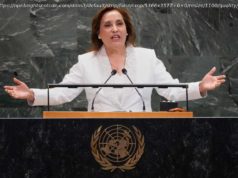In his first days in office, President Donald Trump has taken action on issues including healthcare, abortion, trade and oil pipelines.
March 6 (UPI) — Donald Trump was sworn in as the 45th president of the United States on January 20 and immediately began taking action on a number of issues.
Here’s a rundown of the highlights so far:
(Most recent first)
March 6
Travel Ban: President Trump signed a revised version of an existing order to block entry by people from six majority-Muslim nations for 90 days and ban all refugees from Syria for 120 days. The new order specified that it won’t affect people who had already been issued travel visas.
February 28
Clean Water Act: President Trump signed an executive order calling for a review of an Obama-era rule expanding the number of bodies of water under environmental protection.
Historically Black Colleges and Universities: President Trump signed an executive order moving the federal initiative on HBCUs directly to the White House instead of under the Department of Education in order to „promote excellence,“ the White House said.
Women in Science: President Trump signed two bills aiming to promote women in the STEM fields. The Protecting Women in Entrepreneurship Act calls on the National Science Foundation to „recruit and support women to expand their focus into the commercial world in its entrepreneurial programs. The Inspiring the Next Space Pioneers, Innovators, Researchers and Explorers Women Act requires NASA to encourage women and girls to study science, technology, engineering and mathematics.
Gun Control: President Trump signed a bill nullifying an Obama-era rule aimed at blocking gun sales to people found to be mentally ill.
February 24
Regulatory Reform: President Trump signed an executive order to direct federal agencies to evaluate existing regulations. The action is part of Trump’s plan to eliminate what he views as overreaching, „job-killing“ restrictions.
February 16
Stream Protection: President Trump signed House Joint Resolution 38 , which scraps an Obama administration environmental rule to protect waterways from coal mining waste. Trump’s administration said the rule puts mining companies at a competitive disadvantage.
February 14
Anti-Corruption Repeal: President Trump signed House Joint Resolution 41 , which wipes away a federal rule that requires energy companies to disclose royalties and government payments. The rule was imposed by the Obama administration last year as a transparency measure. Trump’s government said it puts U. S. energy companies at a disadvantage.
February 9
Police Protection: Trump signed an order to review existing laws and produce legislation to better protect federal, state and local law enforcement officers. The action is a response to increased attacks against officers in the past year.
Crime Reduction: The president ordered Attorney General Jeff Sessions to create a new federal task force to share information among agencies, develop strategies, identify deficiencies in current laws, evaluate criminal data and make recommendations for greater safety of U. S. citizens.
Foreign Crime Fighting: Trump issued an executive order prioritizing efforts to prosecute foreign-based crimes like drug and human trafficking. It calls for stricter enforcement of laws already on the books and efforts to „identify, interdict, disrupt, and dismantle transnational criminal organizations. “
February 3
Wall Street Regulation: Trump signed an executive order to ease U. S. fiscal regulations in the Dodd–Frank Wall Street Reform and Consumer Protection Act of 2010 — which was a response to the financial crisis and Great Recession that Trump’s administration called „overreaching. “
Money Manager Rule: The president ordered the Labor Department to review a rule from former President Barack Obama requiring financial managers to act in their clients‘ best interests when handling retirement accounts. The department will determine whether such a mandate is necessary.
January 31
Supreme Court : Trump nominated federal appellate Judge Neil McGill Gorsuch to replace Associate Justice Antonin Scalia on the Supreme Court. Some Democrats promised to filibuster the confirmation process after Republicans refused to hold hearings on former President Barack Obama’s nomination of Merrick Garland after Scalia’s death.
January 30
Federal regulations: Trump signed an executive order requiring that for every new federal regulation on small and large businesses, two existing regulations must be removed. He signed the document after a meeting with small business leaders. Trump said he wants to end regulatory discrepancy between big and small business.
CIA in the NSC: White House spokesman Sean Spicer said the CIA was added to Trump’s National Security Council — something that wasn’t done by former President Barack Obama due to the creation of the national intelligence director post in 2005.
January 28
National Security Council: Trump reorganized the council , adding his chief strategist, Steve Bannon. The council is a panel of officials, most of them Cabinet level, who work with the president to determine the best course of action on security issues.
January 27
Military strength: Trump signed an executive order to provide new resources and equipment to strengthen the U. S. military. The order promises to „rebuild“ American armed forces and upgrade national and global security as part of a strategy that dictates „peace through strength. “ The order directs Defense Secretary James Mattis to assess the country’s military and nuclear capabilities.
Visa vetting: Trump signed an executive order that calls for more intensive security checks for foreign nationals seeking U. S. travel visas. The action stems from a controversial proposal Trump made during his campaign — to prevent certain refugees from nations of concern, like Iraq and Syria, from reaching U. S. shores until they can be cleared.
January 25
Border security: Trump signed an executive action directing federal agencies to prepare for „immediate construction“ of a wall on the U. S.-Mexico border — a controversial project that was at the center of his presidential campaign.
Immigration enforcement: The president signed an executive order to strip federal grant money from so-called „sanctuary cities“ — U. S. municipalities that protect undocumented immigrants from federal prosecution. Trump’s order also seeks to hire 10,000 additional immigration officers, build more detention centers and prioritize immigrants for deportation.






